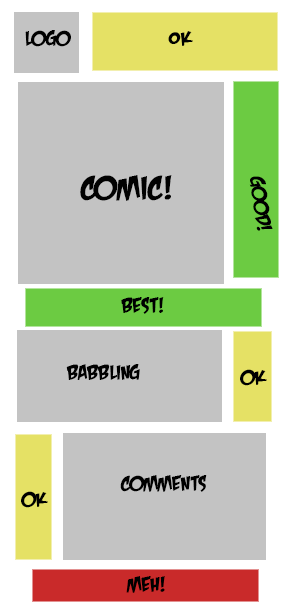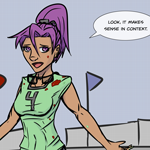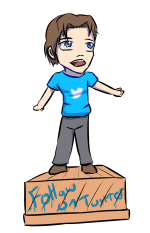It’s been a long time since I’ve made a blog post about advertising your webcomic, but it seemed the time is ripe. For starters, this is prime ad season for people on a budget. A lot of the bigger bidders still have Holiday-season-hangovers on their wallets, people are back at work (and therefore surfing webcomics), and you have new-years-webcomic-traffic resolutions to meet.
I’ve made no secret that I’m fond of Project Wonderful for webcomic advertising (why I leave some up on my site), so today we will cover is how to bid the best for your buck on Project Wonderful!
Finding Sites!
There are two methods to finding sites – organically and with the Project Wonderful searching tools on their site.
To be honest, I recommend organically to start with for a few reasons. To clarify, I mean the approach of ‘go to a webcomic you read, see if they have a PW ad, bid on that ad if it’s a reasonable price’.
- This approach will net you clicks by somewhat compatible readers (chances are, even if a webcomic you read is nothing like your own, there is some sort of cross appeal between something you enjoy reading and something you enjoy writing).
- It will also support authors who make work you’re fond of – this may not be all that important to some people, but it’s one of the main reasons I bid through PW, so it’s a ‘too each their own’ reward there.
- You are assured the ‘quality’ of the site your on – you know it has real traffic by real people; after all, it has people like you going there!
Searching tools however are going to be necessary pretty soon (unless you serial webcomic reader that plows through hundreds of ’em – you know who you are…). This is pretty straight forward.
- Go to their search tool (log in if not already logged in, obviously).
- Under traffic sort by “unique users” – you don’t really care how many page hits they have. Someone loading your ad six times does you very little good if they are not going to click it, you want your ad to be in front of as many people as possible, not loaded as much as possible. Also, unclick “elsewhere”.
- Under “sizes and categories” click “Comics: Webcomics”; honestly this is going to be the best category for you 99% of the time if you are trying to get the most mileage for your dollar. This is PW’s core audience, and reduces shady and spam sites to basically nothing.
- Select ad sizes. I would recommend in generally only bothering with “rectangle”, “skyscrapper” and “leaderboard”; the other slots you can get super cheap sometimes, so if you value money more then blood, sweat and time, leave them checked, but they are usually not worth it.
- Search!
What comes next is up to your budget but you are looking for comics that are in your genre or sites that a ‘good deal’. There are a lot of ways to determine a good deal, but the easiest is if the ‘bid trend’ is down and the ‘unique users’ are not.
You can use ‘tag’s to sort comics before searching, but I find it occasionally leaves out some otherwise good matches, and isn’t worth it.
Ad Placement!
 I made a chart. I’m special like that. Charts are fun.
I made a chart. I’m special like that. Charts are fun.
I would hope that the chart is an eloquent replacement for this entire section, but since I have a pathological attachment to writing too many words, I’ll type more anyway!
While not all webcomics have the same layout, the ads will almost always been in one of the color spaces (if not all of them).
The first bit is fairly self explanatory; right next to or right below the comic are best the prime real-estate. The good stuff. Everyone that is engaged with this comic will see your ad, and think ‘by golly, if I like this comic, I better go read that comic!‘ what can I say, that’s just how ads work.
Some may wonder why the ad the top isn’t also good – the hard reality is that people are really good at not seeing ads up there. While it can still be seen by the casual observer, it’s before they’ve engaged with the page – this means both that they are less likely to ‘see’ it, and that they are less likely to want to leave the page for something else at that point. The second is crucial. You want them after what they came to the page to do, read the comic. They came to this page on purpose, you don’t really want to try to compete with the content or rely on them remembering to come back for your ad!
Now the next two spots are ideal in ‘page flow’ but sadly most readers will not get that far; fortunately the ones that do are far better traffic anyway! People that are actually reading the author’s babble are either really bored or really engaged with the content. Either way, they are the person you want to talk to – and by talk to I mean have click on your ad!
The same goes for the comments; these are webcomic power readers, prime consumers, and really bored/engaged, but it’s even further down.
Now below the comments there is frequently a footer ad. This ad isn’t worthless, but this is well outside of prime real-estate. Not only are precious few of the ‘users’ your seeing actually making it here, but it once again falls peril to ‘dead space’ blindness just like the header. They don’t expect to care about what’s there, so frequently they don’t even really see it. I would only pick up this slot at ‘budget’ rates.
As rough bidding guide; I’d bid half as much for “OK” and a tenth as much for “meh!” slots as I would for “Good” or “Best!” spots.
I hope this has helped some people marshal their thoughts on their bidding strategy or given you some new ideas on how to approach your campaign. If you are worried about getting the most distance for your dollars, always bid by hand. Campaigns are great, but they will eat a lot of bad ad space you wouldn’t bid on by hand no matter how well you set ’em up.
If you have any questions or concerns, feel free to ask in comments or shoot me a message and I’ll see if I can field it. If you’d like to see any other subject covered – I’m thinking about covering bidding strategy for AdWords next, but that’s a bit more of a pain! – let me know!




Discussion ¬